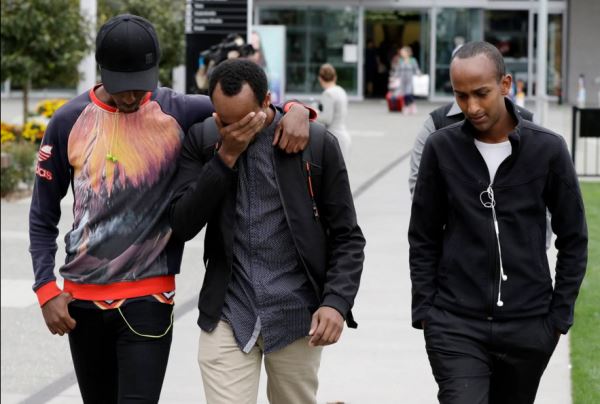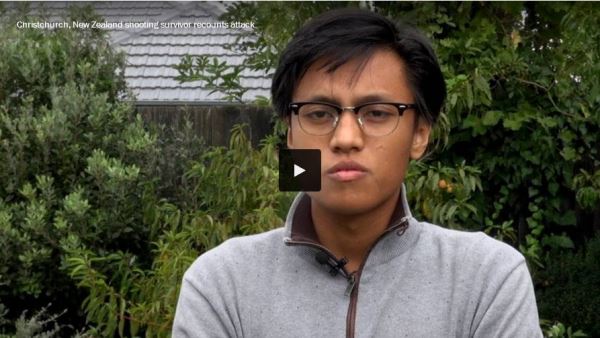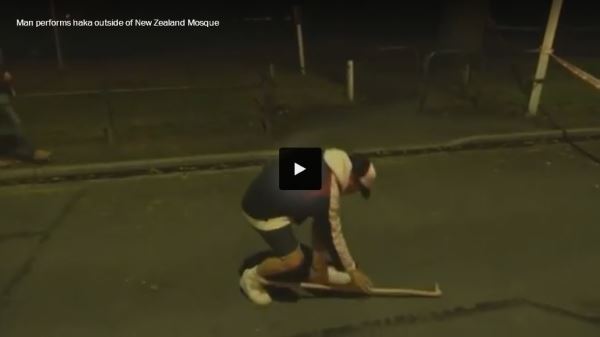Three-year-old Mucad Ibrahim was the youngest victim of the mass shootings in Christchurch, New Zealand. (Abdi Ibrahim/AP)
CHRISTCHURCH, New Zealand — Mucad Ibrahim was wearing little white socks, the type with grips on the bottom so that toddlers don’t slip, when he was carried out of the Al Noor mosque in this city.
His shoes were still at the entrance, where he had left them when he arrived for Friday prayers with his father and older brother. His big brown eyes, usually alight with laughter, were closed as he was rushed to an ambulance.
That was the last time his family saw him.
They hope they will finally get to wash and wrap his tiny body and bury him Monday, much later than is traditional in Islam, which calls for bodies to be interred quickly, preferably within 24 hours.
[Live updates: In wake of massacre, New Zealand debates gun laws]
Mucad, whose name is pronounced “Mou’ad” but who was more commonly called by the Arabic diminutive “Mou’adee,” was 3 years old. He was born in New Zealand to a Somali family who had fled fighting in their home country more than 20 years ago.
Mucad was “energetic, playful and liked to smile and laugh a lot,” his teenage brother Abdi wrote on Facebook. “Will miss you dearly brother.”

Abdifatah Ibrahim, center, and his brother Abdi, right, walk with a friend in Christchurch on Sunday. Mucad was their younger brother. (Mark Baker/AP)
He was the youngest of the 50 victims killed in the attacks on two mosques that have shocked New Zealand and especially this city, which is no stranger to tragedy after a devastating earthquake in 2011 that killed 185 people.
But just as the Sandy Hook massacre in Connecticut caused particular heartache because of the first-grade victims’ innocence, so too does Mucad’s death encapsulate the inexplicability of this man-made disaster.
“He could have grown up to be a brilliant doctor or the prime minister,” said Mohamud Hassan, a 21-year-old member of the Somali community here, which comprises about 60 families. He shook his head, an expression of the common refrain after all mass shootings: “Why?”
[What we know about the people killed in the New Zealand shooting]
Mucad’s father, Adan Ibrahim, had collected him about noon to take him to Friday prayers at the mosque, as usual. After prayers, the young men often went to play soccer in Hagley Park across the road, and Mucad often went with Abdi.

March 17, 2019 | Abdifatah Ibrahim, center, and his brother Abdi, right, walk with an unidentified friend in Christchurch. Abdifatah and Abdi are the older brothers of 3-year-old Mucad, who is the youngest known victim in the mass shooting. (Mark Baker/AP) [click on image for more photos]
But when the gunman stormed into the mosque about 10 minutes into the sermon and started spraying bullets indiscriminately around the men’s section, little Mucad appeared to think it was a scene from the kind of video game his older brothers liked to play. He ran toward the gunman, Hassan said. Amid the chaos, his father and brother ran in different directions.
After the carnage ended, a worshiper carried Mucad to the arriving medics.
On Sunday night, his father was waiting at a hospital, hoping to see his smallest son for the first time since he was killed, hoping that Monday would be the day he could finally lay his youngest to rest.
“Verily we belong to God and to Him we shall return. Will miss you dearly brother,” Abdi wrote.
There is some frustration among families at the length of time it is taking authorities to release the bodies.
Prime Minister Jacinda Ardern said during a news conference Sunday that a few bodies would be returned to their families that night and that she hoped all would be returned by Wednesday.
“Just give us back the bodies,” one woman yelled at the TV screen Sunday afternoon as members of the local Indonesian community gathered to support the family of Lilik Abdul Hamid, an engineer for Air New Zealand who was killed in the attacks.
Some 90 disaster victim identification officers, including 20 from abroad, are working to identify the victims. But Christchurch’s coroner said it was a time-consuming process that included identifying clothing and obtaining medical records and fingerprints.
Wally Haumaha, the deputy police commissioner, said he understood that not being able to comply with religious funeral rites was adding to the families’ trauma.
“Our sole focus is to get their loved ones back and to follow the cultural traditions such as the washing and shrouding of the loved ones,” he said Sunday.
Wally Haumaha, the deputy police commissioner, said he understood that not being able to comply with religious funeral rites was adding to the families’ trauma.
“Our sole focus is to get their loved ones back and to follow the cultural traditions such as the washing and shrouding of the loved ones,” he said Sunday.

Muhammad Luthfan Fadhli, who is 19 and originally from Indonesia, recalled his time inside the mosque where a shooter unleashed gunfire on March 15. (Blair Guild, Kate Evans/The Washington Post)
Heavy machinery was being used to dig dozens of graves at the Memorial Park Cemetery in Christchurch, not far from the site of the second mosque that was attacked. A local funeral home has been designated to receive bodies for families to conduct ritual washings.
But families still don’t know where the funerals will be held. The mosques in Christchurch are still closed.
In front of the Al Noor mosque, where 41 of the victims were killed, streams of people continued to make their way Sunday to the police cordon in the park opposite the mosque. Many laid flowers and left notes expressing condolences or urging them to “kia kaha” — “stay strong” in Maori, the language of New Zealand’s indigenous people.
Some held signs offering free hugs; others gave out home-baked cookies to victims’ families. Members of the Black Power, a motorcycle gang, performed a haka, or Maori dance, on the street opposite the mosque. The haka is often performed to show strength and unity.

A man performed a haka, or Maori dance, March 16, on the street opposite a mosque in Christchurch, New Zealand, following a mass shooting. (Reuters)
And members of the Muslim community streamed back and forth between a family center set up at a community college and the hospital, both across the park from the mosque.
Men of Pakistani heritage wore All Blacks rugby jerseys over their traditional salwar kameez outfits. New Zealanders of Bangladeshi, Syrian, Palestinian and Indian heritage greeted each other with hugs and sorrow. The sounds of Arabic hellos ricocheted around the concrete entrance to the hospital.
Ibrahim Ali, a Somali community leader, greeted some men he didn’t know with, “Hey, where are you from?” “Auckland,” the men in taqiyah, or skullcaps, responded. “No, before that.” Their families were from Fiji.
But at this moment, it was clear that they were all New Zealanders.
“This doesn’t change my feelings about New Zealand,” said Said Abdukadir, whose 70-year-old father was killed in the attacks, which the Australian suspect said he committed specifically to cause shock in a country often lauded for being a safe haven. Abdukadir was late for mosque that day and pulled up just as the gunman was leaving.
“This is what the terrorist wanted,” he said, recalling how his father loved to walk through Hagley Park on his way to the mosque. “He wanted us to feel like we are not safe anywhere. But we know what New Zealand is.”
(The Washington Post)